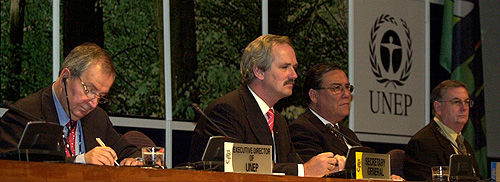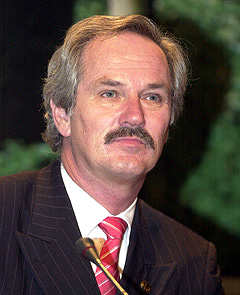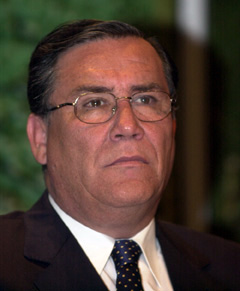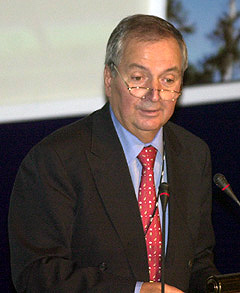|
Committee I addressed, inter alia: the procedure for the review of criteria for amendment of Appendices I and II; quotas for species in Appendix I; conservation of and trade in rhinoceroses and elephants; trade in freshwater turtles, seahorses, bigleaf mahogany and hard coral; transport of live animals; and proposals to amend Appendices I and II. Committee II addressed, inter alia: the relationship between CITES and the Food and Agriculture Organization (FAO) and the International Whaling Commission (IWC); national reports; law and enforcement; ranching; measures to ensure sustainable use of significantly traded plants and animals; trade in bear specimens; bushmeat; a universal labelling system for sturgeon specimen identification; and the CITES information management strategy.
The Budget Committee considered: the financial report for 1997-1999; external funding; expenditures for 2000; Secretariat staffing; the budget for 2001-2002; and the medium-term plan for 2001-2005.
Of the 61 proposals to amend the appendices, 32 were adopted, 17 withdrawn (five of which were replaced by resolutions on further actions) and 12 rejected. In addition, four proposals on whales, four out of the six proposals on African elephants, two proposals of hawksbill turtles and three proposals on sharks were either withdrawn or rejected. South Africa's proposal to transfer its population of African elephants from Appendix I to Appendix II was adopted as amended to induce zero export quotas for raw ivory.
INTERSESSIONAL HIGHLIGHTS
SECOND JOINT MEETING OF THE ANIMALS AND PLANTS COMMITTEES: This meeting convened from 7-9 December 2000, in Shepherdstown, West Virginia, USA, to, inter alia, discuss proposals by the Criteria Working Group on amendments to Resolution 9.24 on criteria for amendment of Appendices I and II.
TENTH MEETING OF THE PLANTS COMMITTEE: The 10th Plants Committee met in Shepherdstown, West Virginia, USA, from 11-15 December 2000. The Committee addressed: follow-up of COP-11 decisions; technical proposals for COP-12, such as the definition of "artificially propagated," standard exemptions for derivatives of plant species, and definitions of technical terms used in annotations for medicinal plants; species proposals for COP-12; significant trade in plants; medicinal plants; review of appendices; and checklists and nomenclature.
SIXTEENTH MEETING OF THE ANIMALS COMMITTEE: The 16th Animals Committee convened from 11-15 December 2000, in Shepherdstown, West Virginia, USA. The Committee addressed, inter alia: transport of live animals; trade in hard coral; traditional medicines; captive breeding and ranching; conservation of seahorses; labelling of caviar; status of sharks; trade in sturgeon, cobra and musk deer; review of animal taxa in appendices; and time-sensitive research samples.
SEVENTEENTH MEETING OF THE ANIMALS COMMITTEE: The 17th Animals Committee met from 30 July - 3 August 2001, in Hanoi, Vietnam. Participants addressed: definition of the term "critically endangered in the wild"; the control of captive breeding, ranching and wild harvest production systems for Appendix II species; trade in freshwater turtles and tortoises; sturgeon; and review of animal taxa.
ELEVENTH MEETING OF THE PLANTS COMMITTEE: The 11th Plants Committee met in Langkawi, Malaysia, from 3-7 September 2001. Participants to the meeting considered: follow-up to COP-11 decisions, such as those regarding agarwood; species and technical proposals for COP-12, such as harvesting of Galanthus; medicinal plants; guidelines for transport in live plants; tree species evaluation; and trade in Mexican cacti.
EIGHTEENTH MEETING OF THE ANIMALS COMMITTEE: The 18th Animals Committee convened from 8-12 April 2002, in San José, Costa Rica, to consider, inter alia: implementation and review of Resolution Conf. 8.9 (Rev.) on significant trade reviews; periodic review of animal taxa; registering and monitoring of operations breeding Appendix I species for commercial purposes; trade in traditional medicines; transport of live animals; trade in hard coral; labelling of caviar; trade in the Black Sea bottlenose dolphin; control of captive breeding, ranching and wild harvest production systems; trade in tortoises and freshwater turtles in Southeast Asia; seahorses; sharks; sturgeon; and trade in alien species.
TWELFTH MEETING OF THE PLANTS COMMITTEE: The 12th Plants Committee convened from 13-16 May 2002, in Leiden, the Netherlands to discuss, inter alia: follow-up of decisions taken at COP-11; technical and species proposals for COP-12; significant trade in plants; medicinal plants; review of the Appendices; checklists and nomenclature; strategic planning; and evaluation of certification schemes. Other issues included de-listing of artificially propagated orchid hybrids and potential future listings of species, such as Devil's Claw (Harpagophytum).
STANDING COMMITTEE: The 47th meeting of the Standing Committee (SC) was held prior to COP-12 in Santiago, Chile to discuss, inter alia: the adoption of the Rules of Procedure, arrangements for COP-12; the Standing Committee workplan and the Strategic Action Plan for 2005; a Memorandum of Agreement between CITES and the United Nations Environment Programme (UNEP); financial and administrative matters; and significant trade in Appendix II species.
|









